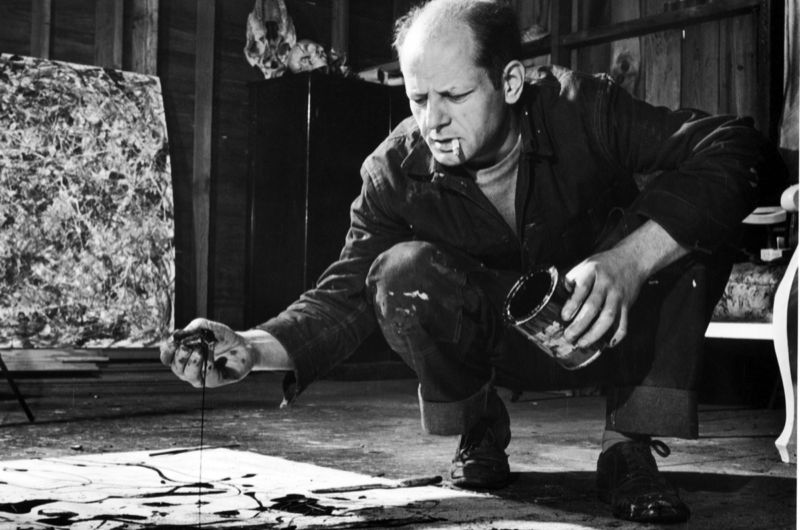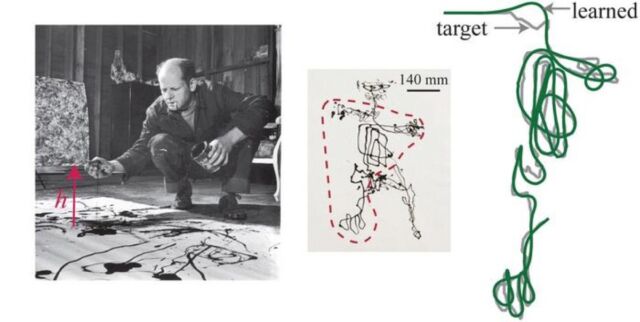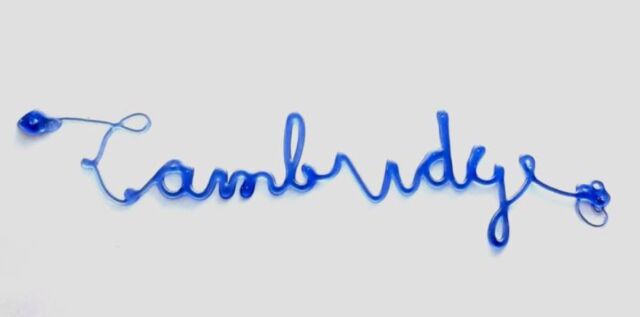
If you've ever drizzled honey on a piece of toast, you've noticed how the amber liquid folds and coils in on itself as it hits the toast. The same thing can happen with 3D and 4D printing if the print nozzle is too far from the printing substrate. Harvard scientists have taken a page from the innovative methods of abstract expressionist artist Jackson Pollock—aka the "splatter master"—to exploit the underlying physics rather than try to control it to significantly speed up the process, according to a new paper published in the journal Soft Matter. With the help of machine learning, the authors were able to decorate a cookie with chocolate syrup to demonstrate the viability of their new approach.
As reported previously, Pollock early on employed a "flying filament" or "flying catenary" technique before he perfected his dripping methods. The paint forms various viscous filaments that are thrown against a vertical canvas. The dripping technique involved laying a canvas flat on the floor and then pouring paint on top of it. Sometimes, he poured it directly from a can; sometimes he used a stick, knife, or brush; and sometimes he used a syringe. The artist usually "rhythmically" moved around the canvas as he worked. His style has long fascinated physicists, as evidenced by the controversy surrounding the question of whether or not Pollock's paintings show evidence of fractal patterns.
Back in 2011, Harvard mathematician Lakshminarayanan Mahadevan collaborated with art historian Claude Cernuschi on an article for Physics Today examining Pollock's use of a "coiling instability" in his paintings. The study mathematically describes how a viscous fluid folds onto itself like a coiling rope—just like pouring cold maple syrup on pancakes.
The patterns that form depend on how thick the fluid is (its viscosity) and how fast it's moving. Thick fluids form straight lines when being spread rapidly across a canvas, but they will form loops and squiggles and figure eights if poured slowly. Mahadevan subsequently measured the thickness of lines and the radius of the coils in a Pollock painting showing this effect, and the team used that data to estimate the flow rate of the paint as the artist's hand moved across the canvas. A 2019 study contradicted that conclusion, finding instead that the vast majority of Pollock's traces were produced because the artist actively avoided coiling instabilities—although the authors acknowledged that theirs was not likely to be the final word on the matter.

Now, Mahadevan has turned his attention to applying what he learned about Pollock's coiling instabilities to direct ink writing, a versatile means of 3D and 4D printing. The drawback is that direct ink writing is a very slow process since any non-uniform flow falling from a height will coil or fold, resulting in defects in the printed objects. That means the print nozzle must be placed just millimeters from the printing surface to exactly mimic the target print pattern. Another limitation is that more complex topologies are difficult to print, and it's also hard to control any sharp turns without distorting the extruded filament.
So rather than focusing on controlling the nozzle, Mahadevan and his co-authors decided to look into how to exploit these coiling instabilities rather than suppress them, just like Pollock did in his paintings. The key is a class of machine-learning algorithms known as reinforcement learning methods, in which the system "learns" through repeated interactions with the environment, correcting its mistakes with each iteration.
“If you look at traditional 3D printers, you supply them a path from point A to point B and the nozzle deposits ink along that specified path,” said co-author Guarav Chaudhary, a former postdoc in Mahadevan's lab, now at MIT. “But Pollock’s approach of throwing paint from a height meant that even if his hand was moving in a specific trajectory, the paint didn’t follow that trajectory because of the acceleration gained from gravity. A small motion could result in a large splatter of paint. Using this technique, you can print larger lengths than you can move because you gain this free acceleration from gravity.”

Mahadevan et al. tested their conclusions from running numerical simulations with a series of laboratory experiments. They used a simple viscous fluid dispersed through a nozzle at a fixed flow rate, depositing the fluid along a predefined path from above a smooth sheet of paper glued onto a flat stationary platform.
Their proof-of-principle experiments used simple fluids with just a single layer of material being printed onto a flat surface—including drizzling chocolate syrup on a textured wafer—to spell out "Cambridge." The team found that printing from a height with their method "naturally handles rough surfaces, unlike the traditional direct-ink write, where an irregular surface will result in irregularities in the deposited material," they wrote.
Future work will tackle the challenge of working with more complex fluids like liquid polymers, pastes, or even foods, as well as stacking multiple layers to create 3D objects. “Harnessing physical processes for functional outcomes is both a hallmark of intelligent behavior and at the heart of engineering design," said Mahadevan. "This little example suggests, once again, that understanding the evolution of the first might help us be better at the second.”
DOI: Soft Matter, 2023. 10.1039/D3SM00177F (About DOIs).
reader comments
24 with